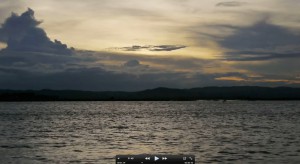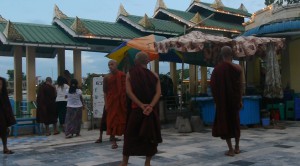PLACES_IN_TIME | Thailand & Myanmar | 2014 | DVD
20 audiovisual moods from Thailand and Myanmar:
Bangkok, Yangon, Shwedagon Pagoda, Mandalay, Mahamuni Buddha Temple, Ayarwaddy River, Bagan, Shwezigon Pagoda, Ananda Temple, Inle Lake, Nyaung Shwe, Shwezarli Pagoda, Bawrithat Pagoda, Koh Chang Island, Lonely Beach.
Recorded between July 22 and August 10, 2013
HD / stereo / 110 min

Mandalay, Ayarwaddy River

Mandalay, Mahamuni Buddha Temple
Review in textura (Canada), February 2015, No 120:
"One of the things that helps make Gruenrekorders products so fascinating is that they encompass such a wide range of styles and genres. In presenting phonography, audio-visual work, and sound art, three recent releases (each a different format) by David Michael and Slavek Kwi, Manfred Waffender, and DinahBird provide an excellent illustration of the labels range.
...
In his Places in Time series, Manfred Waffender creates audiovisual moods of different places, twenty of which are featured on his latest DVD release. Thailand and Myanmar are the focal points of the 110-minute presentation, which follows similarly themed editions focusing on New Zealand, Tansania (Tanzania), Petersberg, Montepulciano, Norway Fjords, New Brighton Beach, and Gentle Annie Point (the first in the series appeared in 2008). In the opening scene, creaks and scrapes produced by a river-based landing station resound as boats dock and riders decamp. Elsewhere, people are seen crowding city streets, outdoor markets, rain-soaked pagoda and temple sites, going about their day-to-day lives shopping, working, and playing. Bells, birds, car horns, voices (speaking and singing), motorboats, fabric-weaving, crashing waves, and popular and traditional musics form part of the soundtrack, and imagery includes both landscape and people-based scenes recorded in the city and country at day and night. Waffender parks his camera in single locations, content to let the abundant visual and auditory detail before the camera provide the necessary stimulation. Scene changes occur with regularity, an approach that gives the work a patchwork-like quality. Visiting the various locations proves to be an educational experience.
...
It is worth noting that while Places in Time: Thailand and Myanmar is an audio-visual project, it can function effectively as a purely audio presentation, too, given that Waffender has designed the sound portion so that it flows continuously.
Reviews
Birkut | Tiny Mix Tapes
PLACES_IN_TIME is an audiovisual series curated by Gruenrekorder mainstay Manfred Waffender. Since 2007, the German multimedia artist has released a combination of books, DVDs, Blu-ray discs, and online video that provide a brief insight into some of the countries he has felt an assumed connection with. His projects have taken him to New Zealand, Norway, Tanzania, Russia, Italy, the UK, Sweden, and most recently, Thailand and Myanmar. The recordings — or “shots,” as he refers to them — that were captured during that last expedition make up the entirety of this intriguing work.
Thailand and Myanmar is only for sale on DVD format, which says something about Waffender’s stance on this particular chapter. This release isn’t available for digital circulation because of the impact that would have on playback — it’s an audiovisual sensation not to be digested over a YouTube channel, but to be appreciated as a whole, without the distraction of other tabs or pop-ups. And even though the visuals are an integral component to the work, they are not necessarily the most fascinating factor. Waffender is Professor for Dramatic Composition in Media at the Robert Schumann School of Music and Media, where he takes classes on writing, editing, shooting, and direction itself. It’s no coincidence, then, that each shot here is wonderfully framed and exceptionally well composed. However, it’s the sonic dimensions that exist within each sequence that differentiate the project from an exercise in contemporary tourism; this is all about the direction of the microphone and taking delight in the theatrical, sensual, and often jarring soundscapes that exist within.
Because I know that time is always time
And place is always and only place
And what is actual is actual for only one time
And only for one place
– T. S. Eliot, Ash-Wednesday, 1930
Each chapter from the PLACES_IN_TIME series is introduced by this epigraph from Eliot. It reads as an admission by Waffender that regardless of what he is presenting, it remains a documentation of an evolutionary process as opposed to a permanent state; whether that be a landscape, a shot of an ocean, or a moonlit sky. On Thailand and Myanmar, his definition of place assumes towns, cities, resorts, and tourist attractions. This might be considered a meager chronicle of personal escapades abroad, if it were not for the deeply inquisitive angles and music (religious, karaoke, street) that can be heard here. It opens with a shot of the Chao Phraya river taken from a small dock; one is immediately drawn in to the subtle knocks and the difficult textures that Waffender highlights. It’s a distilled moment in time, and although the shot is very aware of that fact, it illustrates an unnatural viewpoint that’s framed by the intricate noise of the artist’s surroundings.
In this respect, the visuals act as a tool for framing the sounds rather than the other way around. This is imposing, because the microphone is often pointed in the opposite direction to the camera — it points towards the anonymous chatter at food stands while looking out over the Ayarwaddy river in Mandalay, for instance. One’s own interpretation or appreciation of the audio is stinted by an almost consistently beautiful shot. It’s a peculiar predicament and admittedly a selfish one, but perhaps that awkward sensation lends itself to the project’s appeal. Of course, these shots might feel more powerful in a gallery, but surely this fantastic range of sounds and experiences would lose their intimacy if displayed in a public space.
Indeed, the experience of listening to each clip induces a feeling of scrutiny (or nostalgia — as I can recall being in each of these locations at different points in time), but not from a physical or a visual standpoint. There are certainly some interesting images of the golden Buddha statues with spiraling lights shining behind them, but it’s the chanting that can be heard behind the camera that brings the drama, the tension, and the suspense to this section. And, yes, these feelings are brought about as a consequence of the sounds themselves, but Waffender’s curation also has a great deal to do with that, where he cuts from torrential rainfall, to alleyways, to thicket, even from country to country without a moment’s hesitation.
The audio can often appear warm and intense; it doesn’t always feel as though this is an exploration of a new place from the perspective of an outsider. When that occurs, Waffender uses his compositional tact to arrange the pieces in a way that allows for surprise and even frustration, where the percussive rhythm of manual wooden looms at Inle Lake cut to a still evening scene, which is bustling with the crazed stillness of nature. This happens again when he cuts from the Shwedagon pagoda in Yangon to the crashing waves on Lonely Beach. It makes for a long and unpredictable journey through the artist’s senses. But with patience, the worlds that Waffender reveals unveil a sonic antithesis to the images on the screen, even when taking into account one of the closing sequences: Two female tourists with flowing golden locks walk past a bull on the beach. The bull pauses, before walking straight across the shot, from one side of the frame to the next. Incurious and content.
link
textura
One of the things that helps make Gruenrekorder’s products so fascinating is that they encompass such a wide range of styles and genres. In presenting phonography, audio-visual work, and sound art, three recent releases (each a different format) by David Michael and Slavek Kwi, Manfred Waffender, and DinahBird provide an excellent illustration of the label’s range. […]
In his Places in Time series, Manfred Waffender creates ‘audiovisual moods‘ of different places, twenty of which are featured on his latest DVD release. Thailand and Myanmar are the focal points of the 110-minute presentation, which follows similarly themed editions focusing on New Zealand, Tansania (Tanzania), Petersberg, Montepulciano, Norway Fjords, New Brighton Beach, and Gentle Annie Point (the first in the series appeared in 2008). In the opening scene, creaks and scrapes produced by a river-based landing station resound as boats dock and riders decamp. Elsewhere, people are seen crowding city streets, outdoor markets, rain-soaked pagoda and temple sites, going about their day-to-day lives shopping, working, and playing. Bells, birds, car horns, voices (speaking and singing), motorboats, fabric-weaving, crashing waves, and popular and traditional musics form part of the soundtrack, and imagery includes both landscape and people-based scenes recorded in the city and country at day and night. Waffender parks his camera in single locations, content to let the abundant visual and auditory detail before the camera provide the necessary stimulation. Scene changes occur with regularity, an approach that gives the work a patchwork-like quality.
Visiting the various locations proves to be an educational experience, though the presentation would benefit from the inclusion of titles to clarify the precise location of what’s displayed in the scenes. The sleeve does indicate that Bangkok, Yangon, Mandalay, Ayarwaddy River, Inle Lake, Koh Chang Island, and Lonely Beach are among the locations shown and the DVD ends with a listing of the locations and the dates when the scenes were recorded, but clarifying that onscreen throughout the DVD would assist the viewer unfamiliar with the settings. It’s worth noting that while Places in Time: Thailand and Myanmar is an audio-visual project, it can function effectively as a purely audio presentation, too, given that Waffender has designed the sound portion so that it flows continuously. […]
link